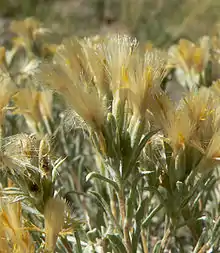Tetradymia canescens
Tetradymia argyraea is a species of flowering plant in the aster family known by the common names spineless horsebrush[1] and gray horsebrush. It is native to western North America.
| Tetradymia canescens | |
|---|---|
 | |
| Scientific classification | |
| Kingdom: | |
| (unranked): | |
| (unranked): | |
| (unranked): | |
| Order: | |
| Family: | |
| Tribe: | |
| Genus: | |
| Species: | T. canescens |
| Binomial name | |
| Tetradymia canescens | |
Distribution
The range of Tetradymia argyraea is primarily east of the Cascade Range and Sierra Nevada of British Columbia to California. It extends eastward to southwest Montana, Wyoming, western Colorado and northwest New Mexico, where it grows in sagebrush scrub, woodlands, forest, scrubby open plains, and other habitat. It occupies a large range of elevations from near sea level to 3,400 m (11,000 ft) but favors the range of 1,500–2,700 metres (5,000–9,000 ft).[2][3]

Description
It is a bushy shrub 10–80 cm (4–31 in) tall with multibranched woody or semi-woody stems that grow from taproots. It is coated in woolly fibers with hairless strips at intervals along the branches. It has no spines. The lance-shaped leaves are no more than 4 cm (1.6 in) long and woolly or silver-haired in texture. Longer-lived leaves are alternately arranged along the stem and smaller, shorter-lived leaves occur in clusters near the axils of the primary leaves. The inflorescence bears usually three to six flower heads which are each enveloped in four thick phyllaries coated in white woolly hairs. Each head contains four tubular flowers in shades of pale to bright yellow, each 7–15 mm (0.3–0.6 in) long. Flowers are produced in May through October. The fruit is an achene 7–15 mm (0.3–0.6 in) long including its long pappus of bristles.[5][6][4]
The shrub is wildfire-resistant, resprouting vigorously and increasing in herbage and seed production in seasons following a fire.[7] Fire suppression efforts decrease the abundance of the shrub and frequent burns increase it.[7]
The shrub is toxic to sheep, causing photosensitivity, bad wool quality, abortion, and death due to the presence of furanoeremophilanes.[7] It causes a swelling of the head known as bighead disease.[7][8]
Native American groups used this plant for a number of medicinal purposes, including protection from ghosts and witches.[9]
References
- "Tetradymia canescens". Natural Resources Conservation Service PLANTS Database. USDA. Retrieved 9 December 2015.
- Sullivan, Steven. K. (2020). "Tetradymia canescens". Wildflower Search. Retrieved 2020-09-22.
- USDA, NRCS. (2020). "Tetradymia canescens". The PLANTS Database. National Plant Data Team, Greensboro, NC 27401-4901 USA. Retrieved 2020-09-22.
- "Tetradymia canescens". in Jepson Flora Project (eds.) Jepson eFlora. Jepson Herbarium; University of California, Berkeley. 2020. Retrieved 2020-09-22.
- Klinkenberg, Brian (Editor) (2020). "Tetradymia canescens". E-Flora BC: Electronic Atlas of the Plants of British Columbia [eflora.bc.ca]. Lab for Advanced Spatial Analysis, Department of Geography, University of British Columbia, Vancouver. Retrieved 2020-09-22.CS1 maint: extra text: authors list (link)
- Giblin, David (Editor) (2020). "Tetradymia canescens". WTU Herbarium Image Collection. Burke Museum, University of Washington. Retrieved 2020-09-22.CS1 maint: extra text: authors list (link)
- US Forest Service Fire Ecology
- Poisonous Plants by Toxic Syndrome. USDA ARS.
- Ethnobotany
External links
 Media related to Tetradymia canescens at Wikimedia Commons
Media related to Tetradymia canescens at Wikimedia Commons- Flora of North America
- CalPhotos gallery